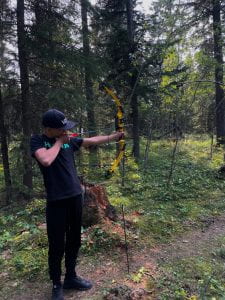Hi, and welcome back to another blog! This is my first one for maker this year and it was on a really fun unit, film and goal setting! In this project we were given a book to help us with our goal setting called “What do you really want?” We also made a series of videos to help teach us the different aspects of film. In this post I will include the three different videos that I made, as well as various activities from my goal tracker, like my goal ladder. This was all so we could answer our driving question, “How can I use my video skills to tell a story?”

Goal tracker
Our goal trackers were more or less a journal of sorts that we would do our activities in. I think that the two most important things that we did in our goal trackers were our goal ladders and talking about SMART goals. A SMART goal stands for specific, measurable, actionable, relatable, and timed. This is important because a SMART goal is more or less the essence of what every goal should be to help you to achieve it. The other thing that was major was the goal ladder. This is something that I will talk more about later.
Videos
For each video, there was a specific aspect of film that we were really trying to incorporate. The first video was about us learning out main tool, Clips, and it was also about what inspires me. This was probably the easiest of the videos, only because we could just use videos we already had. I think I did a good job at getting all the necessary information across but my story aspect of it could have been a lot better.
Check out the video on Cam’s YouTube channel here
The second video that we did was our silent film. The main focus for us was the shots and angles that we used. To make this video, me and my group, Cam and Makenzie, took a story about someone achieving their goals from the book, and put it into an Old-Timey style with all the angles we had learned. We decided on doing a story about a kid and karate, that I think turned out very well. The one thing that I think we could’ve done better would have been to make certain parts, like the train montage, a bit longer and showcase more of the angles that we needed.
The final maker video that we made was about how to set goals. It was also about us using all of our skills that we’ve worked on throughout the project to showcase a story about, you guessed it, goal setting. In this video me and my group, Tom and Evangeline, took a story about one of us achieving a goal and keyed it out onto a storyboard. We then spent the next day or so filming and editing until we had a product that was ready to be presented. To end this all off, our class had a mini viewing party where we watched all the group’s videos. The main thing that I think we could have done better with the video would have been to have our goal ladder clearer and more of a main part.
Goal ladder

My goal ladder something that I did within my goal tracker. In my goal ladder, I chose a SMART goal from my goal tracker and really broke it down. I had to lay it out in 10 different steps with dates on when I wanted to get each step done. The goal that I decided to do was to build a home gym in my garage. This goal is fairly short term, since I could get it done in about a month or two. The only problem that I’ve ran into with my goal so far, is that I haven’t had enough time to start it properly. I’ve done the first 3 steps, but not thorough enough.
In the end, I think that I did a good job of using my videos to tell a story. I learned about how different angles can really help get different things across, like using an angle to make a scene more dramatic. I also learned about, and was able to make, storyboards. A storyboard is an amazing way of planning out your story to make it easier to know what you’re doing, instead of just going in blind. My best example was the final we did. In it, I was able to use all of our strategies to make a video with a clear story.




